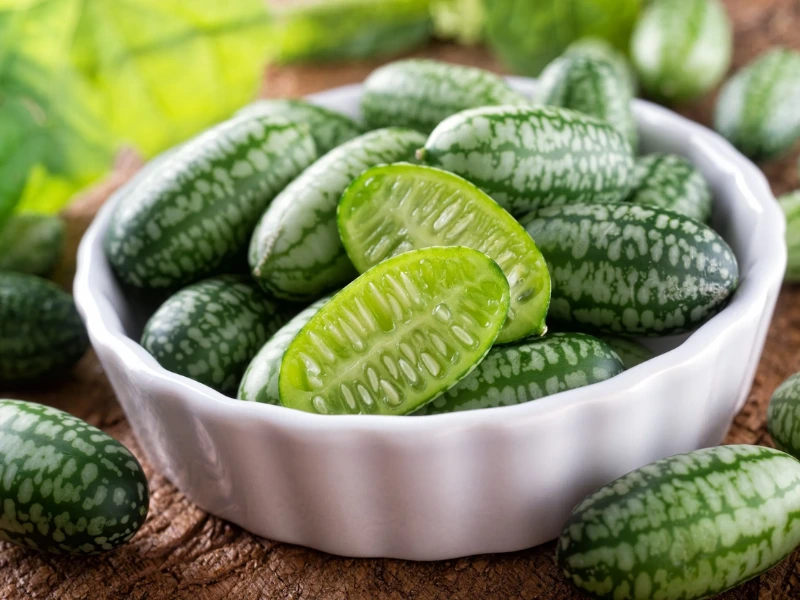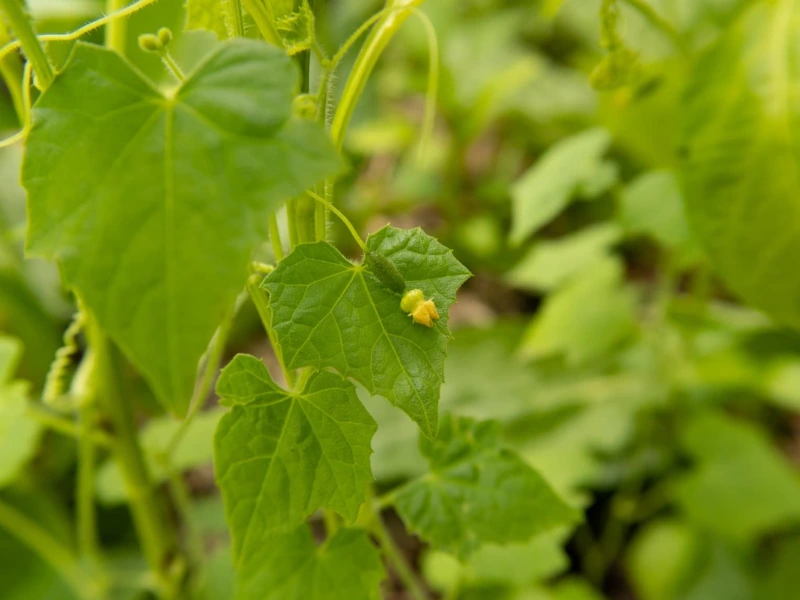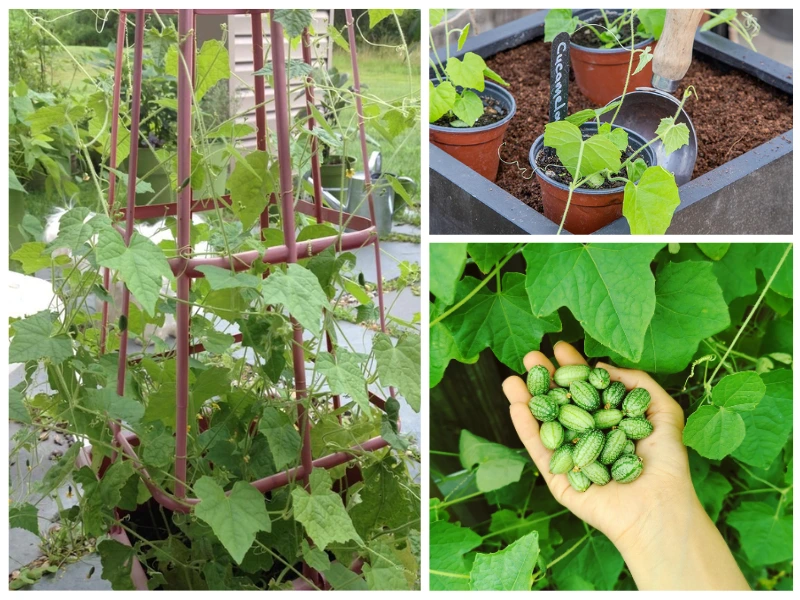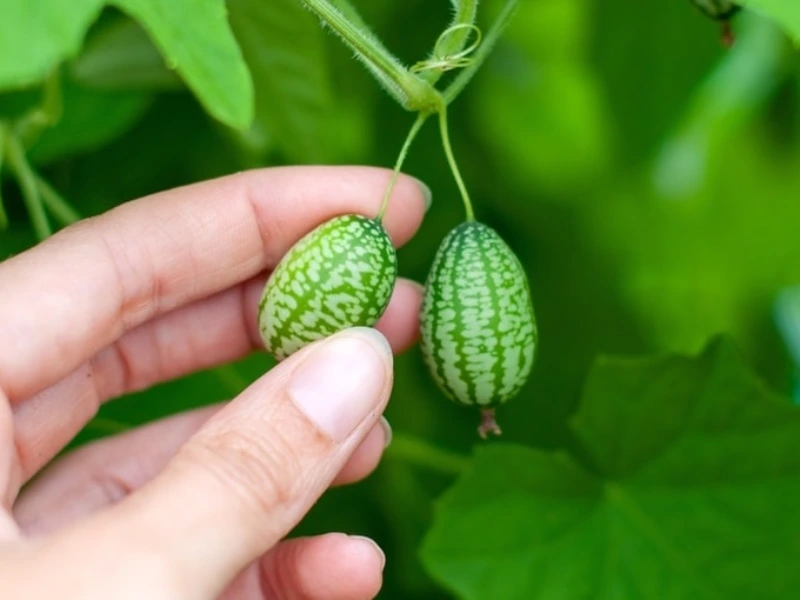Are you looking for a unique and delicious plant to grow in your garden or apartment? If so, you’ve probably heard of cucamelons. These tiny, grape-sized fruits, also known as Mexican sour gherkins, are adorable and incredibly versatile in the kitchen. Whether you’re a seasoned gardener or just starting, growing cucamelon in pots is an excellent choice, especially for small spaces. This guide will walk you through everything you need to know to successfully grow cucamelons in pots, with tips on selecting the right container, caring for your plants, and enjoying the harvest.
What is a Cucamelon?

Before we dive into the growing process, let’s take a closer look at the star of the show: the cucamelon. Scientifically known as Melothria scabra, this unique plant is native to Mexico and Central America. It produces small, watermelon-like fruits with a sour, cucumber-like taste. Often referred to as “Mexican sour gherkins,” cucamelons are perfect for adding a refreshing bite to salads, cocktails, or just as a snack.
Cucamelons are fast-growing and naturally drought-resistant, making them a great choice for gardeners of all skill levels. They’re ready to harvest about 75 days after planting the seeds in spring, and their compact size makes them ideal for container gardening. If you’re looking for a pint-sized edible plant to grow or want to try something less common, cucamelons are always a fun and rewarding choice. Plus, their delicate vines can be trained to climb trellises or fences, adding beauty to your garden while providing a bountiful harvest.
Why Grow Cucamelon in Pots?

Growing cucamelons in pots offers several benefits, especially for gardeners with limited space. Here’s why you should consider it:
Perfect for Small Spaces
Cucamelons thrive in containers, making them an ideal option for apartment dwellers or those with small balconies. These plants don’t require a lot of space to grow, but they do need a sunny spot to flourish.
Convenience and Mobility
Unlike traditional garden beds, pots allow you to move your cucamelon plants around. This means you can position them in the best spot for sunlight or even bring them inside during colder months. If you live in a place with unpredictable weather, growing cucamelons in pots is a smart solution.
Best Containers for Growing Cucamelons
When it comes to selecting the right container for your cucamelons, size, material, and drainage are the key factors to consider.
Choosing the Right Cucamelon Pot Size
Cucamelons grow best in containers that are at least 12 inches deep. A larger pot allows for better root development, leading to healthier plants and higher yields. If you’re growing multiple plants, choose a larger container to ensure they have enough space to spread out.
Material and Drainage Considerations
While you can use almost any type of pot, the material plays a role in your plant’s health. Terra cotta pots are a popular choice because they provide excellent drainage, but plastic pots work well too, as long as they have adequate drainage holes. Good drainage prevents water from accumulating at the bottom of the pot, which can lead to root rot.
How to Plant Cucamelons in Pots
Now that you have the right container, it’s time to plant your cucamelons. Here’s a step-by-step guide to help you get started:
Preparing the Pot and Soil
Start by filling your pot with high-quality, well-draining soil. Cucamelons prefer slightly acidic to neutral soil (pH of 6.0 to 7.0). Mix in some organic compost to enhance soil fertility and ensure your plants get all the nutrients they need. Make sure the pot has plenty of drainage holes to avoid waterlogging.
Planting Seeds or Seedlings
You can start cucamelons from seeds or buy young plants from a nursery. If starting from seeds, plant them about 1 inch deep in the soil. Space the seeds or seedlings at least 6 inches apart to give each plant room to grow. If you’re planting indoors, make sure the pot is placed in a sunny location with plenty of direct sunlight (at least 6 hours a day).
Care and Maintenance for Cucamelons in Containers

Once your cucamelons are planted, the next step is to provide the right care to ensure they thrive. Follow these tips to keep your plants healthy and productive:
Watering and Fertilizing
Cucamelons need consistent moisture but should never be overwatered. Water the plants when the top inch of soil feels dry. During hot summer months, you may need to water more frequently. Make sure the soil is well-draining, as standing water can cause the roots to rot.
As for fertilizing, cucamelons benefit from a balanced, all-purpose fertilizer. Apply fertilizer every 4-6 weeks during the growing season to encourage strong, healthy growth.
Pruning and Supporting Vines
Cucamelons are vine plants that will need some support as they grow. Use a trellis or other vertical support structure to help the vines climb. Prune the plants regularly to remove dead or damaged leaves and to encourage more branching, which results in more fruit. Pinching off the top of the vines once they reach about 3 feet tall will encourage the plant to spread out and produce more cucamelons.
Dealing with Pests and Diseases
Like all plants, cucamelons are susceptible to pests and diseases. Aphids, spider mites, and whiteflies are common pests that may target cucamelons. To keep these pests under control, inspect your plants regularly and use insecticidal soap or neem oil if necessary. Additionally, avoid overwatering to prevent fungal diseases like powdery mildew.
Harvesting Cucamelons from Pots

Cucamelons are typically ready to harvest within 70 to 80 days after planting, depending on growing conditions. The fruits are small, about the size of a grape, and look like tiny watermelons when ripe.
When and How to Harvest
You’ll know cucamelons are ready to harvest when they turn a pale green color and have a firm texture. Simply pluck them from the vine and enjoy them fresh, or store them in the fridge for up to a week. Cucamelons can be eaten fresh, pickled, or added to various dishes.
Care Tips for Growing Cucamelons in Pots Indoors
Growing cucamelons indoors can be a rewarding experience, but it requires a bit of extra attention to ensure they thrive. Here are some key care tips for successfully growing cucamelons in pots indoors:
1. Provide Adequate Light
Cucamelons need at least 6 hours of direct sunlight each day. Place your pot near a south or west-facing window where it can soak up plenty of light. If natural light is insufficient, consider using a grow light to supplement.
2. Maintain Consistent Temperature
Cucamelons prefer temperatures between 70°F and 85°F (21°C – 29°C). Keep them in a warm spot, away from drafts or cold windows, as they are sensitive to extreme temperature changes.
3. Water Properly
While cucamelons are drought-resistant, they still require consistent moisture. Water the plants when the top inch of soil feels dry, but ensure the pot has good drainage to prevent waterlogging and root rot.
4. Use Well-Draining Soil
Indoor pots can easily retain excess moisture, so be sure to use a well-draining potting mix. A blend of peat, perlite, and compost is ideal to promote healthy root growth and prevent water retention.
5. Provide Vertical Support
As cucamelons are vine plants, they will need support to climb. Use a small trellis or stakes to help them grow vertically, which also helps save space and keeps the plant healthier.
Frequently Asked Questions
1. Can Cucamelons Be Grown Indoors?
Yes! Cucamelons thrive indoors if they have access to plenty of sunlight. Place them near a sunny window or use a grow light to provide the necessary light for healthy growth.
2. What Is the Best Pot Size for Cucamelons?
A pot that is at least 12 inches deep is ideal for cucamelons. The larger the pot, the better the roots can spread, leading to stronger plants and better fruit production.
3. How Often Should I Water Cucamelons in Pots?
Water your cucamelons when the top inch of soil feels dry to the touch. Be sure to provide consistent moisture but avoid overwatering, as this can lead to root rot.
4. Can Cucamelons Be Grown in Small Pots?
While cucamelons can technically be grown in smaller pots, larger pots (12 inches or more in diameter) provide the best environment for healthy growth and high fruit production.
Conclusion
Growing cucamelons in pots is an excellent choice for anyone looking to grow a unique, low-maintenance, and delicious plant. Whether you’re gardening in a small apartment or on a spacious balcony, cucamelons thrive in containers, providing you with a tasty snack all summer long. By following the steps outlined in this guide—selecting the right pot, providing proper care, and harvesting your cucamelons at the right time—you’ll be on your way to enjoying these delightful fruits right from your own home.
Now that you know how to grow cucamelons in pots, it’s time to get started! Visit Garden Nursery to purchase cucamelon seeds or seedlings, and start your gardening journey today. Happy gardening!
